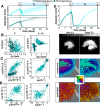From cells to tissue: How cell scale heterogeneity impacts glioblastoma growth and treatment response
- PMID: 32101537
- PMCID: PMC7062288
- DOI: 10.1371/journal.pcbi.1007672
From cells to tissue: How cell scale heterogeneity impacts glioblastoma growth and treatment response
Abstract
Glioblastomas are aggressive primary brain tumors known for their inter- and intratumor heterogeneity. This disease is uniformly fatal, with intratumor heterogeneity the major reason for treatment failure and recurrence. Just like the nature vs nurture debate, heterogeneity can arise from intrinsic or environmental influences. Whilst it is impossible to clinically separate observed behavior of cells from their environmental context, using a mathematical framework combined with multiscale data gives us insight into the relative roles of variation from different sources. To better understand the implications of intratumor heterogeneity on therapeutic outcomes, we created a hybrid agent-based mathematical model that captures both the overall tumor kinetics and the individual cellular behavior. We track single cells as agents, cell density on a coarser scale, and growth factor diffusion and dynamics on a finer scale over time and space. Our model parameters were fit utilizing serial MRI imaging and cell tracking data from ex vivo tissue slices acquired from a growth-factor driven glioblastoma murine model. When fitting our model to serial imaging only, there was a spectrum of equally-good parameter fits corresponding to a wide range of phenotypic behaviors. When fitting our model using imaging and cell scale data, we determined that environmental heterogeneity alone is insufficient to match the single cell data, and intrinsic heterogeneity is required to fully capture the migration behavior. The wide spectrum of in silico tumors also had a wide variety of responses to an application of an anti-proliferative treatment. Recurrent tumors were generally less proliferative than pre-treatment tumors as measured via the model simulations and validated from human GBM patient histology. Further, we found that all tumors continued to grow with an anti-migratory treatment alone, but the anti-proliferative/anti-migratory combination generally showed improvement over an anti-proliferative treatment alone. Together our results emphasize the need to better understand the underlying phenotypes and tumor heterogeneity present in a tumor when designing therapeutic regimens.
Conflict of interest statement
The authors have declared that no competing interests exist.
Figures









Similar articles
-
Quantitative Clinical Imaging Methods for Monitoring Intratumoral Evolution.Methods Mol Biol. 2017;1513:61-81. doi: 10.1007/978-1-4939-6539-7_6. Methods Mol Biol. 2017. PMID: 27807831 Review.
-
Recurrence of glioblastoma is associated with elevated microvascular transit time heterogeneity and increased hypoxia.J Cereb Blood Flow Metab. 2018 Mar;38(3):422-432. doi: 10.1177/0271678X17694905. Epub 2017 Feb 24. J Cereb Blood Flow Metab. 2018. PMID: 28273720 Free PMC article.
-
Quantitative metrics of net proliferation and invasion link biological aggressiveness assessed by MRI with hypoxia assessed by FMISO-PET in newly diagnosed glioblastomas.Cancer Res. 2009 May 15;69(10):4502-9. doi: 10.1158/0008-5472.CAN-08-3884. Epub 2009 Apr 14. Cancer Res. 2009. PMID: 19366800 Free PMC article.
-
Image-driven modeling of the proliferation and necrosis of glioblastoma multiforme.Theor Biol Med Model. 2017 May 2;14(1):10. doi: 10.1186/s12976-017-0056-7. Theor Biol Med Model. 2017. PMID: 28464925 Free PMC article.
-
Basic principles of mathematical growth modeling applied to high-grade gliomas: A brief clinical review for clinicians.Neurol India. 2018 Nov-Dec;66(6):1575-1583. doi: 10.4103/0028-3886.246238. Neurol India. 2018. PMID: 30504543 Review.
Cited by
-
Modeling How Heterogeneity in Cell Cycle Length Affects Cancer Cell Growth Dynamics in Response to Treatment.Front Oncol. 2020 Sep 10;10:1552. doi: 10.3389/fonc.2020.01552. eCollection 2020. Front Oncol. 2020. PMID: 33042800 Free PMC article.
-
Mathematical Modeling and Mutational Analysis Reveal Optimal Therapy to Prevent Malignant Transformation in Grade II IDH-Mutant Gliomas.Cancer Res. 2021 Sep 15;81(18):4861-4873. doi: 10.1158/0008-5472.CAN-21-0985. Epub 2021 Jul 31. Cancer Res. 2021. PMID: 34333454 Free PMC article.
-
Data-driven spatio-temporal modelling of glioblastoma.R Soc Open Sci. 2023 Mar 22;10(3):221444. doi: 10.1098/rsos.221444. eCollection 2023 Mar. R Soc Open Sci. 2023. PMID: 36968241 Free PMC article. Review.
-
In Silico Mathematical Modelling for Glioblastoma: A Critical Review and a Patient-Specific Case.J Clin Med. 2021 May 17;10(10):2169. doi: 10.3390/jcm10102169. J Clin Med. 2021. PMID: 34067871 Free PMC article. Review.
-
Evidence for age-related contributions of DNA damage and epigenetics in brain tumorigenesis.Int J Exp Pathol. 2021 Dec;102(6):232-241. doi: 10.1111/iep.12402. Epub 2021 Oct 30. Int J Exp Pathol. 2021. PMID: 34716726 Free PMC article.
References
-
- Saeed-Vafa D, Bravo R, Dean JA, El-Kenawi A, Mon Père N, Strobl M, et al. Combining radiomics and mathematical modeling to elucidate mechanisms of resistance to immune checkpoint blockade in non-small cell lung cancer. Bioarxiv. 2017;190561.

